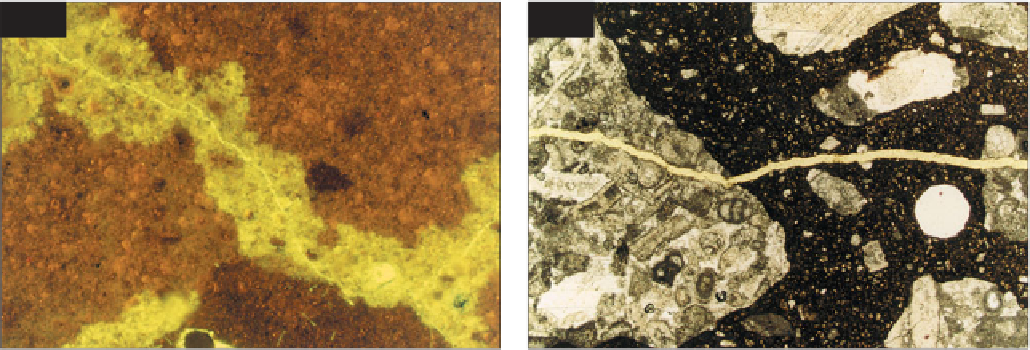Geoscience Reference
In-Depth Information
W
EATHERING BY LEACHING
,
FROST ATTACK
,
AND
SALT CRYSTALLIZATION
Dense, good-quality concrete is resistant to weathering
owing to its low permeability. However, most external
surfaces will eventually show evidence of deterioration
caused by natural weathering processes such as cyclic
wetting and drying, leaching, freeze-thaw mechanisms,
and salt crystallization.
Leaching of the cement matrix occurs when moisture
is able to pass through concrete. Calcium hydroxide
(portlandite) is leached from cement hydrates and may
be deposited within air voids or cracks (
199
).
Consequently, the leached cement matrix may appear
depleted of portlandite crystallites. Ettringite may also be
leaching from the cement matrix to line voids and cracks
(
200
). Abundant secondary deposits of ettringite
associated with cracks may be symptomatic of sulfate
attack of the aluminate phases, rather than just leaching
of existing ettringite. The importance of moisture
penetrating through concrete is frequently
underestimated as a cause of damage to concrete (French,
1991a). Major leaching will cause considerable
weakening of the cement matrix. Moisture is also
required for natural weathering processes such as frost
attack and salt crystallization and promotes deleterious
reactions such as sulfate attack and AAR.
In hardened concrete, cracks running perpendicular to
the surface (slabs and walls) may be caused by early age
thermal movement or drying shrinkage. A certain
amount of microcracking of the cement matrix is present
in all concrete and is considered to be a normal concrete
feature. The amount of microcracking caused by drying
shrinkage is related to the W/C of the concrete, with more
being present at higher W/C. Figure
197
shows a
shrinkage microcrack within a concrete bleeding channel
with localized high W/C. Microcracks generated by
shrinkage tend to meet at triple junctions in the paste, to
radiate from aggregate surfaces, run along parts of
aggregate surfaces, and initiate on voids (French, 1991a).
In reinforced concrete, expansion due to ASR or DEF
causes patterns of fine cracks on concrete surfaces, along
with cracking and microcracking at depth. The various
cracks may be filled with secondary deposits of alkali-
silica gel or sulfate minerals that may also exude on to
concrete surfaces. Reinforcement corrosion causes
cracking, spalling, and delamination of concrete often
with associated brown rust deposits. Crack patterns
associated with deleterious reactions are discussed later
in their respective sections. Cracking caused by structural
movement often runs through the aggregate particle as
well as the cement matrix. Figure
198
shows concrete
from a concrete cladding panel that cracked due to
flexural loading of the panel in service.
197
198
197
Close view of a microcrack (yellow) in the
cement matrix of structural concrete. The microcrack
has formed in a zone of high microporosity associated
with a bleeding channel (light green); UV, ×150.
198
Structural cracking of a concrete cladding panel.
A crack (yellow) runs both through the cement matrix
(dark brown) and limestone coarse aggregate particles
(light brown); PPT, ×35.




